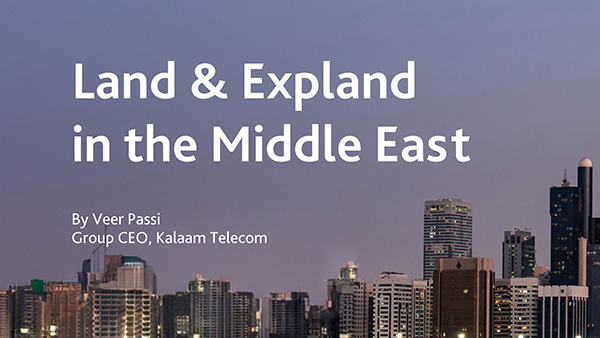The Middle East is one of the most dynamic and fastest growing digital economies in the world. It represents a huge opportunity for service providers and enterprises delivering on global digital transformation. Connecting users internationally requires the delivery of consistent application experience and quality of service across a global footprint. The vast majority of digital transformation requirements are no longer about connecting A to B or simple point-to-point connections and instead, they require the ability to offer platforms which enable organisations to seamlessly deploy new applications and services on a real-time basis as and when they are required.
The global appetite for digital transformation is accelerating at an unprecedented rate. IDC forecasts global digital transformation investments to hit $3.4 trillion by 2026. Within the Middle East and North Africa (MENA) region, the digital economy is predicted to hit $400 billion by 2030 according to research conducted by Redseer Strategy Consultants. This represents a huge opportunity for service providers and enterprises.
Enterprises and service providers continue to look for a one-stop-shop partner to help them enter the region as effortlessly as possible, whilst ensuring they can achieve success and scale.
New market, new processes
The Middle East can be a complicated and complex market to navigate. Understanding the local operational environment, regulations, best practices, and digital infrastructure can be challenging to say the least. Added to this, enterprises and service providers find themselves having to manage multiple partners across the region as they enter new countries and new markets.
Each market has its own nuances which can be complex for service providers from outside of the region to navigate. A common misconception is that the telecom landscape is homogenous throughout. In reality, each country has its own incumbent operators and unique ways of doing business. Navigating inter-regional requirements can be daunting and can impact both growth and profitability. Significant time and resource investment are required for any service provider or enterprise wishing to enter a new market, let alone the highly complex and fragmented Middle Eastern landscapes. Thus, preventing those entities who need to focus on serving their customers as well as the needs of their own unique business requirements.
Agility in connecting the cloud
When connecting to the cloud, service providers and enterprises must move with new levels of agility to not fall behind their competitors. Organisations cannot afford to be encumbered by the need to negotiate deals with each country individually as they grow. The nature of the cloud means a much faster way of doing business is required to meet market expectations.
According to Capifly, MENA cloud services revenue grew to $3 billion in 2020, an increase of 21% from the previous year, and this trajectory continues to build which is in turn driving the adoption of Software-as-a-Service in the region.In 2023 Gartner predicts IT spending in the region will grow 2% from $171.9 billion in 2022
To overcome the complexities of expanding into the Middle East, European service providers and enterprises need a robust ‘land and expand’ strategy that includes the right regional networking partner. The partner should be able to understand the business objectives of the enterprise or service provider and provide a single platform that enables the newcomer to have just one single contract to provide a seamless customer experience across the entire region.
The partner should be able to offer adaptability and agility to enable service providers and enterprise businesses to scale up across the region whenever and wherever opportunities arise.
As well as the above, the right partner will also enable the service provider to provide consistent application support and customer experience across markets to avoid a disconnect. This will enable both service providers and enterprises to realise new opportunities and monetise investments in the region in a quick and successful manner.
By streamlining all requirements into the partners’ single, unified network, the need for multiple contracts, technical integrations, and compliance regulations is eliminated, thereby reducing the volume of resources required. Risk is also significantly reduced if the infrastructure is wholly owned by the partner, eliminating the possibility of interference from other parties. The partner, therefore, removes barriers to growth and enables businesses to deliver global digital transformation.
With a one-stop shop partner, enterprises and service providers can expect faster and more reliable connectivity across the region. It should be able to leverage long-standing, established local relationships, resilient infrastructure and to bypass traditional roadblocks. All these factors provide a competitive edge.
Article by
Veer Passi
Group CEO, Kalaam Telecom

